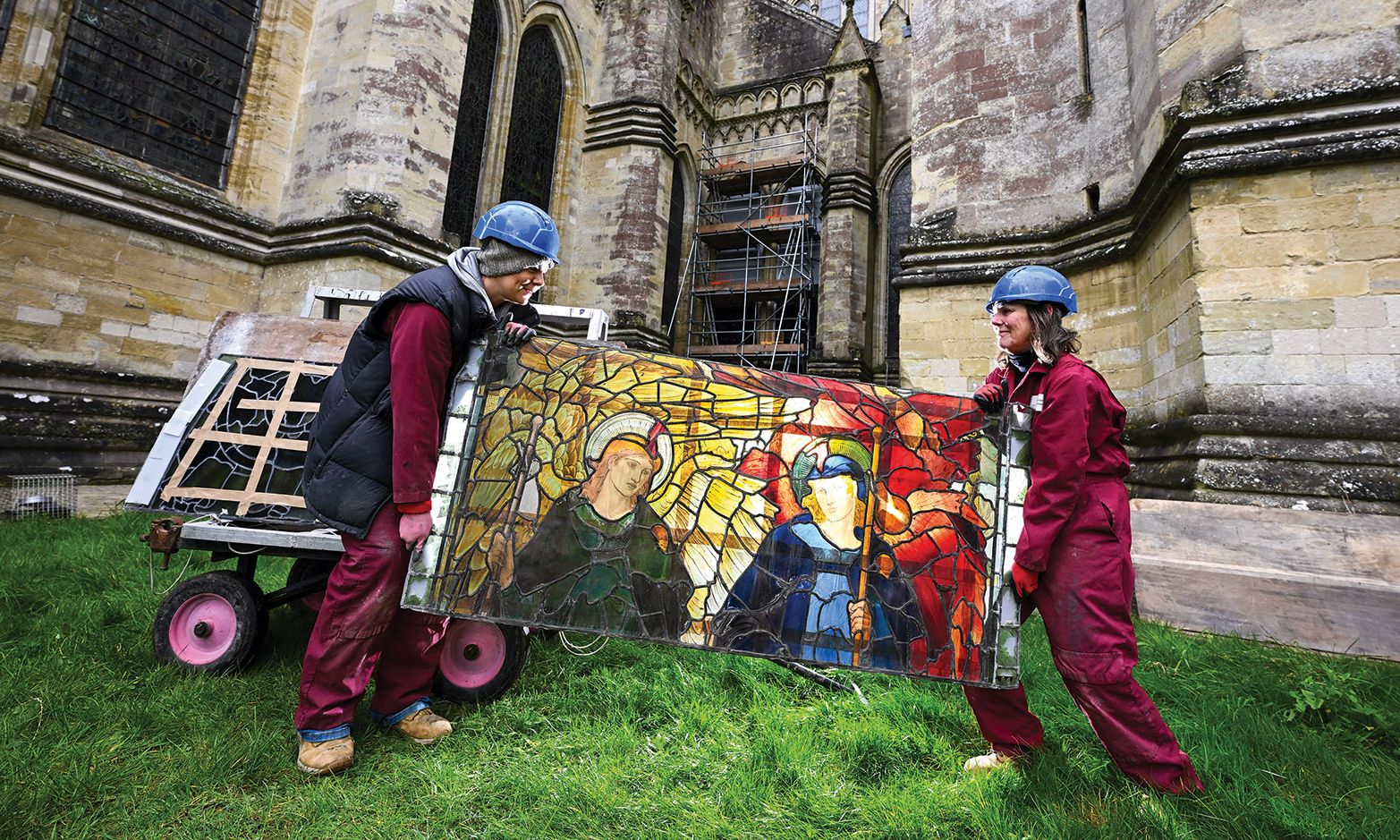Conservators Vicky Pearce (left) and Kate Kersey (right) with a section of Angeli Ministrantes; Burne-Jones’s window consists of two lancets, each featuring a pair of angels Finnbarr Webster
Since its installation in 1879, the stained-glass Burne-Jones Window in the south choir aisle of Salisbury Cathedral has often gone unnoticed, obscured from view by the polychrome stone bulk of the 17th-century Mompesson Monument. Designed by Edward Burne-Jones and made by the William Morris workshop, the window has now been removed for conservation—for the first time in its 145-year history.
As well as cleaning away accumulated dirt, the treatment, anticipated to cost nearly £120,000, will restore painted detail and introduce a layer of protective glazing. The work is expected to take two years and, once completed, should secure the window for another 200 years, according to Sam Kelly, the cathedral’s head glazier and conservator.
“Our initial suspicion was that it was just filthy dirty—which it is—but when we got within 15 feet of it, when works to the organ were taking place a few years ago, we could see that some of the detail had faded”, Kelly says. “We knew that there were water ingress issues. It’s down on the cathedral inventory as ‘A star’, so we really needed to do something about it.”
The window comprises two lancets, each containing a pair of angels titled Angeli Ministrantes and Angeli Laudantes (ministering and praising angels). The figures sit within an acanthus leaf design by Morris.
Commissioned by the wife and sisters of George Eyre Townsend RA of nearby Mompesson House, the window seems originally to have been conceived as part of a larger project, and represents the culmination of the 19th-century stained-glass revival in Britain, driven by a fashion for memorial windows such as this one.
When Morris, Marshall, Faulkner & Company (later Morris & Co) began trading in 1861, stained-glass work accounted for “between two-thirds and three-quarters of turnover in its first decade”, according to the historian Peter Cormack. Though prized for Burne-Jones’s draughtsmanship and Morris’s eye for colour and design, it was the quality of glass used that set Morris & Co apart.
In collaboration with others, including the historian Charles Winston and Whitefriars Glassworks, Morris led the recovery of lost medieval techniques and skills. “William Morris was instrumental in getting mouth-blown English antique glass made—this nice kind of glass with the variegations through it,” Kelly says, pointing out the ripples, bubbles and striations that suggest the line and flow of drapery, wings or hair. “Prior to this, glass is a much flatter-looking thing—much less interesting.”
Though consensus recognises Morris windows as the best, their quality varies—not only among the many hundreds that exist across the country but within a single example. The problems now surfacing at Salisbury are largely due to the way the glass was made and installed.
Morris’s glass studio operated much like a medieval workshop, with individuals assigned specific tasks. But though executed by the very best painters, the characteristically black, beautiful lines of the faces and draperies were poorly fired, leaving the paint as a powder on the surface of the glass. This was subsequently washed away by condensation, a significant problem before heating was installed in the cathedral in the 1960s.
The problem is exacerbated in some areas by poor glass cutting, combined with the way the windows were leaded, which left inadequate space for the cement. The cement has washed out, letting water through.
This was a poor decision, not a cost-cutting measure, but inconsistencies in the firing may be a consequence of an overstretched workshop, Kelly says. “If it came out of the kiln and it was not quite fired, maybe they were just too busy to do it again; they wanted to get to the next stage because there’s another load coming on behind.”
Missing strings in one of the angel’s harps may be further evidence of a workshop running at full tilt. With no evidence of fading, the omission may be the result of a later repair, but “we may find that they just didn’t paint that bit, and they were too rushed to put it right when they were making the window up”, Kelly says.
Such relentless pressures contrast with the utopian working conditions described by Morris, and it is easy to imagine the temptation to re-use designs across the various media that the firm worked in. Angeli Laudantes became a popular tapestry design, and the Fitzwilliam Museum holds a pair of detailed coloured chalk drawings of Angeli Ministrantes and Laudantes. These drawings, probably by Burne-Jones, may have been the basis for cartoons made for the construction of the Salisbury windows.
Comparison with other, well-fired Burne-Jones windows is another important reference for conservators. The Salisbury designs themselves were used in other windows, including for the home of the Australian mining magnate George McCulloch, of which one well-preserved panel survives.
So, Kelly and his team have various sources to consult when they come to redrawing the lines of the faces and hair, as well as some of the draperies and wings. This will be done by painting onto clear pieces of glass, superimposed on the original to create an entirely reversible, non-invasive repair. Because the lines in the foliage are largely in good condition, these will be retained in their original leading where possible, with the entire window placed inside a layer of glass that will “put it in as near to a museum environment as you could get while keeping it in place.”
This has already been done for all of Salisbury’s medieval windows but one, and is especially important now, Kelly says, since if heating were ever to become unaffordable, condensation would once again become a threat. For now, the window is in the vanguard: as Burne-Jones windows reach an age where conservation is necessary, securing their future brings with it an unprecedented view inside the Morris & Co workshops.

